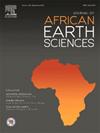Inception and evolution of the Turkana Depression: A review from the perspective of the longest-lived sector of the East African Rift
IF 2.2
4区 地球科学
Q2 GEOSCIENCES, MULTIDISCIPLINARY
引用次数: 0
Abstract
The Turkana Depression comprises a highly anomalous sector of the East African Rift (EAR), distinct in its antiquity, structural complexity, geomorphology and attenuated crustal architecture. Previous studies inferred these distinctions derive from pre-existing lithospheric heterogeneities, especially Cretaceous–early Paleogene Central African Rift (CAR) tectonism. Yet, Paleogene extensional deformation is neither clearly typical CAR, nor EAR. Instead, extension gradually evolved from primarily plate-driven (slab pull), to a hybrid state where mantle plume-related (active) processes became increasingly important (particularly c. 23- 7 Ma) to one after c. 7 Ma where active rifting processes dominate. Significant extension accommodated by dyke intrusion in Turkana probably didn't begin until the Pleistocene, accompanied by basin inversion. From c. 30 Ma extension transitioned from the CAR to the Gulf of Aden-Red Sea (GARS) region, marked by Late Oligocene inversion in the CAR trend and parts of Turkana (recorded by outcrop geology and low-temperature thermochronology). Neotethys slab pull helped drive Cretaceous-Palaeogene extension, but was gradually eliminated by the Zagros collision (Early Miocene?) and diachronous opening of the GARS spreading centres (Middle Miocene). Across this transitional period, seismic reflection data indicates total upper crust Cenozoic extension is < 40 km. Conversely, Moho topography suggests >120 km extension. Given the absence of major Cretaceous basin development in western Turkana, probably pre-Cretaceous thinning and/or initially thin crust is required to explain the discrepancy. Turkana Eocene-Miocene extension rates were variable, but low (c. 1 mm/yr) before Plio-Pleistocene acceleration to Holocene-Recent rates of c. 4–5 mm/yr. The CAR, with its very limited volcanism and three phases of extension, separated by inactive periods and crustal cooling, challenges the idea that East African lithosphere is too strong to extend without a plume or magma assistance. However, mantle-weakening, magma-assisted processes accompanying early mantle plume activity probably operated at depth in the western Turkana Depression from c. 40–55 Ma onwards, and may explain the onset of Palaeogene rifting.
求助全文
约1分钟内获得全文
求助全文
来源期刊

Journal of African Earth Sciences
地学-地球科学综合
CiteScore
4.70
自引率
4.30%
发文量
240
审稿时长
12 months
期刊介绍:
The Journal of African Earth Sciences sees itself as the prime geological journal for all aspects of the Earth Sciences about the African plate. Papers dealing with peripheral areas are welcome if they demonstrate a tight link with Africa.
The Journal publishes high quality, peer-reviewed scientific papers. It is devoted primarily to research papers but short communications relating to new developments of broad interest, reviews and book reviews will also be considered. Papers must have international appeal and should present work of more regional than local significance and dealing with well identified and justified scientific questions. Specialised technical papers, analytical or exploration reports must be avoided. Papers on applied geology should preferably be linked to such core disciplines and must be addressed to a more general geoscientific audience.
 求助内容:
求助内容: 应助结果提醒方式:
应助结果提醒方式:


